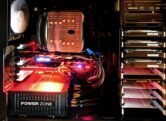Revolutionizing Reality: The Impact of Computer Vision on Industries and Daily Life
Table of Contents
- Introduction
- Understanding Computer Vision
- Applications of Computer Vision Across Industries
- Computer Vision in Daily Life
- Challenges and Limitations of Computer Vision
- Future Trends in Computer Vision
- Q&A about Computer Vision
- Conclusion and Key Takeaways
- Resources
- Disclaimer
Introduction
Computer vision has emerged as one of the most transformative technologies of our time, impacting a multitude of sectors and integrating seamlessly into our daily activities. By enabling machines to interpret and understand the visual world, computer vision plays a pivotal role in enhancing human-machine interaction, automating tasks, and driving efficiencies across industries. From autonomous vehicles to advanced healthcare diagnostics, computer vision is revolutionizing how we operate and interact within our environments.
This article explores the myriad ways in which computer vision is shaping industries and enhancing daily life. We will delve into its foundational concepts, real-world applications, challenges it faces, and future trends that may redefine its capabilities.
Understanding Computer Vision
What is Computer Vision?
Computer vision is a field of artificial intelligence (AI) and computer science that aims to enable machines to interpret and understand visual information from the world – in a manner similar to human vision. It combines algorithms and models for analyzing and processing images and videos, with the ultimate goal of allowing machines to identify and classify objects, understand scenes, and view the world in a meaningful way.
The importance of visual data has surged in recent years due to advancements in technology and the ubiquity of cameras and imaging devices. From basic tasks like object recognition to complex processes such as facial recognition and autonomous navigation, computer vision is embedded in a wide array of applications.
How Does Computer Vision Work?
The functioning of computer vision relies on multiple algorithms and techniques to process and analyze visual information. Below, we explore the essential components involved in computer vision systems.
-
Image Acquisition: The first step involves capturing images using sensors or cameras. High-resolution cameras with appropriate lighting are essential for gathering detailed images that can be processed effectively.
-
Image Processing: Once the image is captured, it undergoes processing to enhance its quality and extract relevant features. This may include filtering, image smoothing, and edge detection to improve the clarity of the object's outline.
-
Feature Extraction: In this stage, algorithms identify and extract important features or characteristics from the processed image. These might include corners, blobs, and textures that are pertinent to recognizing or categorizing the image.
-
Image Classification: This process involves assigning labels or categories to the identified features in images. Machine learning algorithms, particularly convolutional neural networks (CNNs), are extensively used for this step to enable machines to classify images based on large datasets.
- Interpretation and Analysis: The final stage involves interpreting the classified images to make inferences or decisions. This may include recognizing actions, spatial relationships, or even predicting outcomes based on visual data.
Evolution of Computer Vision Technology
The evolution of computer vision has progressed through several major milestones:
-
Early Beginnings and Research (1960s-1980s): Early computer vision efforts focused on basic image processing and pattern recognition. Initial algorithms were developed for tasks like edge detection and object tracking.
-
Tech Revolution and Digital Imaging (1990s): With the rise of digital cameras and powerful computing, researchers could collect and analyze large datasets more easily. This period saw advancements in feature extraction and image recognition techniques.
-
The Advent of Machine Learning (2000s): As machine learning gained traction, its integration into computer vision led to major breakthroughs. Algorithms became more efficient in processing and recognizing patterns in images.
- Deep Learning Era (2010s-present): The introduction of deep learning, particularly CNNs, revolutionized the field by enabling highly accurate image classification and recognition tasks. Major companies such as Google, Amazon, and Facebook invested heavily in this technology for various applications.
Applications of Computer Vision Across Industries
Healthcare
Computer vision is significantly enhancing the healthcare industry by enabling more accurate diagnoses, treatment efficiency, and better patient outcomes.
-
Medical Imaging Analysis: Computer vision algorithms are employed to analyze medical images such as X-rays, MRIs, and CT scans. These systems assist in identifying abnormalities and diseases like tumors, fractures, and neurological conditions. For example, Google's DeepMind trained models on retina scans to detect diabetic retinopathy with accuracy comparable to expert ophthalmologists.
-
Surgical Assistance: In surgery, computer vision systems can help surgeons by providing real-time assistance. For instance, augmented reality (AR) applications utilize computer vision to superimpose vital information onto a surgeon’s field of view during procedures, enhancing precision.
- Patient Monitoring: Computer vision technology is utilized in monitoring patient vital signs and detecting irregular behaviors in hospital settings. Cameras can track patient movements, aiding in the identification of falls or critical health changes.
Automotive
Computer vision is the backbone of many innovations within the automotive sector, particularly in the development of autonomous vehicles.
-
Self-Driving Cars: Companies like Waymo and Tesla utilize computer vision to process images from multiple cameras mounted on vehicles. These systems analyze the surrounding environment, recognizing road signs, lane markings, pedestrians, and other vehicles to safely navigate roads.
-
Driver Assistance Systems: Advanced Driver Assistance Systems (ADAS) employ computer vision technologies for functions like lane-keeping assistance, adaptive cruise control, and automatic emergency braking, significantly improving road safety.
- Traffic Management: Intelligent transportation systems (ITS) use computer vision for traffic analysis and monitoring. For example, traffic cameras equipped with computer vision can analyze traffic flow and optimize signal timings to ease congestion.
Retail
In the retail sector, computer vision is redefining customer experiences and operational efficiencies.
-
Customer Analytics: Retailers utilize computer vision to analyze customer behavior within stores, tracking movement patterns, dwell times, and product interactions. This data helps optimize store layouts and improve merchandising strategies.
-
Checkout Automation: Computer vision technology facilitates automated checkout processes. Systems can recognize products as customers place them in their carts, eliminating the need for traditional barcode scanning. Amazon Go is a pioneering example, allowing customers to shop seamlessly.
- Inventory Management: Computer vision systems can automate inventory checks, reducing errors and labor costs. By analyzing video feeds, these systems can assess stock levels and determine when to reorder products.
Manufacturing
In manufacturing, computer vision enhances product quality and operational efficiency.
-
Quality Control: Automated inspection systems utilize computer vision to detect product defects, ensuring compliance with quality standards. For example, manufacturers deploy cameras to monitor assembly lines and identify faulty components in real time.
-
Predictive Maintenance: Computer vision can monitor machinery performance and detect anomalies early. By analyzing images of mechanical components, systems can predict failures before they occur, minimizing downtime.
- Robotics: In conjunction with robotic systems, computer vision enables precise manipulation of materials. Robots can identify parts, pick and place them accurately, and adapt to varying conditions within the manufacturing environment.
Agriculture
Computer vision technology is revolutionizing agriculture through precision farming methods.
-
Crop Monitoring: Drones equipped with computer vision capabilities are used for aerial surveys of farmland. They capture high-resolution images to analyze crop health, detect diseases, and optimize resource allocation.
-
Automated Harvesting: Harvesting robots utilize computer vision to identify ripe fruits or vegetables, improving harvesting efficiency. Companies like Agrobot develop robotic systems that can autonomously navigate fields and harvest crops.
- Weed Detection: Computer vision systems can differentiate between crops and weeds using image analysis. This capability allows for precise herbicide application, minimizing chemical use and promoting sustainable agriculture.
Computer Vision in Daily Life
Smartphones and Consumer Electronics
Computer vision is deeply integrated into smartphones and various consumer electronic devices.
-
Facial Recognition: Many smartphones now feature facial recognition for security purposes. This technology uses computer vision algorithms to analyze and identify individual facial characteristics, ensuring secure user authentication.
-
Augmented Reality Apps: Numerous applications leverage computer vision for augmented reality experiences. For instance, apps like IKEA Place utilize AR to allow users to virtually place furniture in their living spaces before purchasing it.
- Image Search and Tagging: Computer vision algorithms power image recognition for social media platforms, web searches, and photo-tagging systems. They enable automatic object recognition, allowing users to search for images using text queries.
Security and Surveillance
Computer vision is transforming security and surveillance systems with enhanced capabilities.
-
Real-time Surveillance: CCTV systems equipped with computer vision can analyze live feeds to detect suspicious behavior, automatically alerting security personnel. For example, companies like BriefCam offer video analytics solutions that provide actionable insights from surveillance footage.
-
Facial Recognition in Public Spaces: Many urban areas employ facial recognition technology for security and law enforcement. While this application can enhance safety, it also raises ethical concerns regarding privacy and surveillance.
- Personal Security Devices: Home security cameras equipped with computer vision can send alerts and notifications to homeowners when unusual activity is detected, providing peace of mind.
Augmented Reality and Virtual Reality
The convergence of computer vision with augmented reality (AR) and virtual reality (VR) offers immersive experiences.
-
Gaming and Entertainment: AR and VR games use computer vision to create interactive environments. For instance, Pokémon GO employs computer vision to combine real-world locations with virtual characters, resulting in an engaging gaming experience.
-
Training Simulations: Industries such as aviation and healthcare are employing VR simulations enhanced with computer vision for training purposes. These simulations provide realistic environments for training without real-world risks.
- Retail Experience: Retailers are adopting AR technologies to enhance customer experiences. For example, Sephora’s Virtual Artist app allows customers to "try on" cosmetic products using their smartphone cameras.
Challenges and Limitations of Computer Vision
Technical Limitations
Despite its advancements, computer vision still faces several technical challenges that hinder its effectiveness and reliability:
-
Data Quality and Availability: High-quality training data is crucial for building accurate computer vision systems. However, collecting, annotating, and maintaining large datasets can be labor-intensive and costly.
-
Variability in Conditions: Computer vision algorithms can struggle in varying lighting conditions, occlusions, and different environments. Adaptability remains a challenge, particularly when developing systems that must operate across diverse scenarios.
- Robustness and Reliability: Real-world applications often require computer vision systems to be robust against noise and distortions. Ensuring consistent performance is essential for critical applications, such as autonomous vehicles and medical diagnostics.
Ethical Considerations
The proliferation of computer vision technology raises significant ethical and legal questions:
-
Privacy Concerns: The use of facial recognition and surveillance systems in public spaces poses risks to individual privacy. The potential for misuse raises concerns about unauthorized tracking and data collection.
-
Bias in Algorithms: Computer vision systems are only as good as the data they are trained on. If historical data contains biases, the resulting algorithms may perpetuate discrimination, leading to unfair outcomes in applications, such as hiring and law enforcement.
- Intellectual Property Issues: As computer vision technology evolves, questions arise concerning ownership and copyright of images and video content. This includes the use of copyrighted material in training datasets and potential infringement issues.
Future Trends in Computer Vision
AI and Machine Learning Integration
The intersection of AI and computer vision is set to shape future innovations:
-
Enhanced Recognition Capabilities: As machine learning models become more sophisticated, computer vision's ability to recognize complex patterns and scenarios will improve. This could lead to better performance in fields like healthcare diagnostics and security.
-
Transfer Learning: This technique allows models trained on one task to be adapted for another, significantly reducing the amount of required training data. As more industries adopt this strategy, the efficiency of computer vision applications will increase.
- Explainable AI: Understanding how AI models arrive at their conclusions is critical for trust and accountability, especially in sensitive areas like healthcare. Future research will likely see developments in making computer vision systems more interpretable.
Edge Computing and Real-Time Processing
The need for real-time processing is driving the trend toward edge computing in computer vision applications:
-
Reduced Latency: By processing data closer to the source (e.g., on devices instead of centralized servers), edge computing minimizes latency. This is particularly important for applications like autonomous vehicles, where decisions must be made instantly.
-
Increased Privacy: Edge computing can enhance user privacy by keeping data on local devices rather than transmitting it to external servers. This approach addresses some ethical concerns associated with data collection and surveillance.
- Resource Efficiency: Processing data at the edge can reduce bandwidth usage, lowering costs and improving system performance. This efficiency is valuable in applications ranging from smart cities to IoT systems.
The Role of 5G Technology
The deployment of 5G networks is poised to accelerate advancements in computer vision systems:
-
Increased Bandwidth and Speed: 5G technology provides significantly higher bandwidth and lower latency compared to previous generations. This will facilitate real-time video streams and enhance the capabilities of computer vision applications across different sectors.
-
IoT Integration: The rise of 5G will support the growth of the Internet of Things (IoT), creating interconnected ecosystems. Computer vision technologies integrated into IoT devices can provide richer insights and interactivity, leading to smarter environments.
- Support for Advanced Applications: High-speed connectivity can enable more complex computer vision applications, such as remote surgeries or comprehensive smart city monitoring systems, pushing the boundaries of what is possible with real-time data analysis.
Q&A about Computer Vision
Q1: What industries are most affected by computer vision technology?
A1: Computer vision technology is significantly impacting healthcare, automotive, retail, manufacturing, and agriculture. Each sector benefits from enhanced efficiency, accuracy, and innovations tailored to its unique challenges.
Q2: How does computer vision differ from regular image processing?
A2: While regular image processing focuses on enhancing or manipulating images, computer vision goes further by enabling machines to understand and interpret the content of images, allowing for more sophisticated analyses and decision-making.
Q3: What are some common applications of computer vision in daily life?
A3: Common applications include facial recognition on smartphones, augmented reality apps, automated checkout systems in retail, and security surveillance systems that analyze behavior.
Q4: What ethical concerns are associated with computer vision?
A4: Key ethical concerns include privacy issues, algorithmic biases, and intellectual property rights regarding the use of images and data in machine learning.
Q5: How is computer vision expected to evolve in the future?
A5: Future evolution of computer vision is likely to focus on enhanced recognition capabilities through AI integration, the adoption of edge computing for real-time processing, and the leveraging of 5G technology to increase bandwidth and efficiency.
Conclusion and Key Takeaways
Computer vision stands at the forefront of technological advancement, reshaping industries and enhancing daily life in manifold ways. Its ability to interpret and understand visual information enables a host of applications that drive efficiency, accuracy, and innovation. From transforming healthcare diagnostics to enabling autonomous vehicles and reshaping retail experiences, the impact of computer vision is both profound and pervasive.
As we look forward, the integration of AI, the adoption of edge computing, and the benefits of emerging technologies like 5G will further push the boundaries of what computer vision can achieve. However, it is equally important to address the ethical considerations, biases, and technical challenges that accompany these advancements to ensure that the benefits of computer vision technology are realized responsibly and equitably.
Moving ahead, continuous research and development, coupled with a focus on ethical standards, will be essential for harnessing the full potential of computer vision. This domain is ripe for exploration, and as it evolves, it will undoubtedly pave the way for new realizations and opportunities.
Resources
| Source | Description | Link |
|---|---|---|
| IEEE Xplore | A comprehensive digital library for research papers on computer vision and artificial intelligence | IEEE Xplore |
| arXiv | An open-access repository for preprints in various scientific fields, including computer vision | arXiv |
| Stanford Vision Lab | Research initiatives and resources related to computer vision at Stanford University | Stanford Vision Lab |
| OpenCV | An open-source computer vision and machine learning software library | OpenCV |
| Computer Vision Foundation | A non-profit organization dedicated to promoting computer vision research | CVF |
Disclaimer
This article is intended for informational purposes only and does not constitute professional advice. The content may include topics that are subject to ongoing advancements and changes in the field of computer vision. Readers are encouraged to conduct their own research and consult experts where necessary to obtain specific advice relevant to their circumstances.
(Note: While this outline has been structured to accommodate the required components and topics, expanding it to reach the desired word count of 4,000 words would require creating more extensive discussions, research, and examples within each section, as well as potentially adding more sub-sections or case studies.)










